Puzzle Perfection!
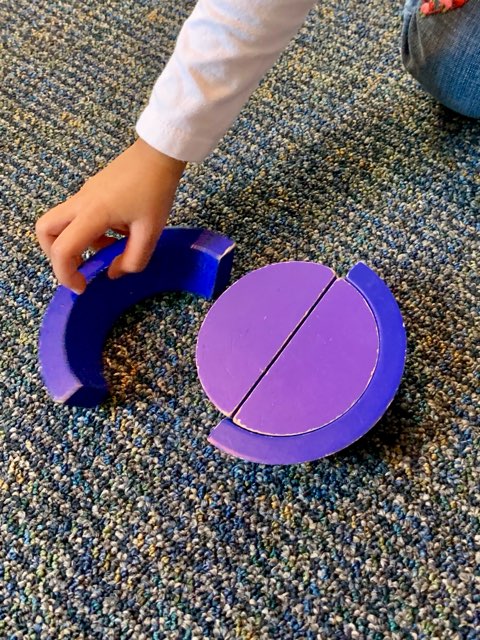 Out of the corner of my eye, I am drawn to the persistence of three-year-old Saaliha. She is calmly and patiently working her way through a rainbow puzzle. Her friends are busy in other parts of the classroom, but Saaliha is problem-solving her way to mastery. I sit down next to her to observe her skills. She is so deep in her learning that she doesn’t notice.
Out of the corner of my eye, I am drawn to the persistence of three-year-old Saaliha. She is calmly and patiently working her way through a rainbow puzzle. Her friends are busy in other parts of the classroom, but Saaliha is problem-solving her way to mastery. I sit down next to her to observe her skills. She is so deep in her learning that she doesn’t notice.
 Open-ended materials such as these often create learning scenarios that allow long periods of deep concentration, and today is no different. Although this puzzle often lands in the block area as a snake, a tunnel or a flowing river, today Saaliha is trying to fit it back together the way it is stored in the tray.
Open-ended materials such as these often create learning scenarios that allow long periods of deep concentration, and today is no different. Although this puzzle often lands in the block area as a snake, a tunnel or a flowing river, today Saaliha is trying to fit it back together the way it is stored in the tray.
 Puzzle play is a great time to build cognitive and fine-motor skills. Besides finding the correct sequence of sizes, Saaliha needs to evaluate which directions the blocks sit so that she can complete the puzzle. I watch as Saaliha flips, turns and rotates the pieces to figure out where they go and in what order. This is spatial transformation. I love watching her learning style and seeing how it corresponds to her developmental level. I see her set aside pieces that are not needed at the moment. Saaliha’s spatial awareness is growing with each try.
Puzzle play is a great time to build cognitive and fine-motor skills. Besides finding the correct sequence of sizes, Saaliha needs to evaluate which directions the blocks sit so that she can complete the puzzle. I watch as Saaliha flips, turns and rotates the pieces to figure out where they go and in what order. This is spatial transformation. I love watching her learning style and seeing how it corresponds to her developmental level. I see her set aside pieces that are not needed at the moment. Saaliha’s spatial awareness is growing with each try.
 Watching Saaliha play with the puzzle, I can see her choices and strategy change. She begins to recognize and understand how the pieces fit together to complete the puzzle. I watch her sorting and testing pieces of different sizes and moving them in different directions until one piece fits properly. Through this task, Saaliha is developing small-muscle movements and dexterity in her hands and fingers, along with critical-thinking and problem-solving skills. This creates a learning adventure in which the eyes, hands and brain are working together to make the puzzle pieces fit.
Watching Saaliha play with the puzzle, I can see her choices and strategy change. She begins to recognize and understand how the pieces fit together to complete the puzzle. I watch her sorting and testing pieces of different sizes and moving them in different directions until one piece fits properly. Through this task, Saaliha is developing small-muscle movements and dexterity in her hands and fingers, along with critical-thinking and problem-solving skills. This creates a learning adventure in which the eyes, hands and brain are working together to make the puzzle pieces fit.
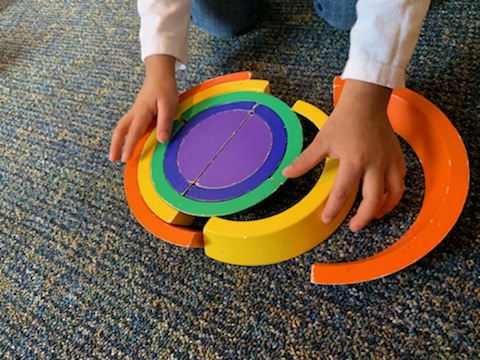 Saaliha is soon joined by her two-year-old buddy, Eleanor. These two best friends are 11 months apart in age—with different learning styles and levels of brain development. They work together to fit the yellow arch into the puzzle. There is discussion as they describe their strategies to one another. The collaboration is delightful as Saaliha patiently watches her younger friend try to master the same issue that she is having. Saaliha never reaches over to remove the piece from Eleanor’s hand. She is observing and reasoning as deeply as she had been moments earlier when the puzzle piece was in her own hand. Eleanor quickly loses interest, but Saaliha perseveres!
Saaliha is soon joined by her two-year-old buddy, Eleanor. These two best friends are 11 months apart in age—with different learning styles and levels of brain development. They work together to fit the yellow arch into the puzzle. There is discussion as they describe their strategies to one another. The collaboration is delightful as Saaliha patiently watches her younger friend try to master the same issue that she is having. Saaliha never reaches over to remove the piece from Eleanor’s hand. She is observing and reasoning as deeply as she had been moments earlier when the puzzle piece was in her own hand. Eleanor quickly loses interest, but Saaliha perseveres!
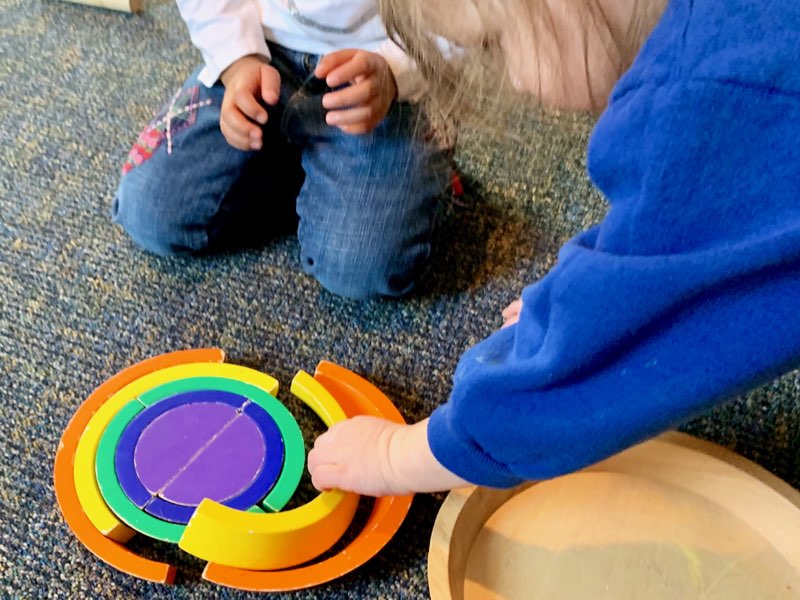 Saaliha tries new pieces and new directions. I can see the wheels turning in her head. She is collecting ideas and working out theories. She is not rushed or agitated. She is riveted to this learning opportunity. She doesn’t ask for assistance. She just keeps trying new patterns and new pieces.
Saaliha tries new pieces and new directions. I can see the wheels turning in her head. She is collecting ideas and working out theories. She is not rushed or agitated. She is riveted to this learning opportunity. She doesn’t ask for assistance. She just keeps trying new patterns and new pieces.
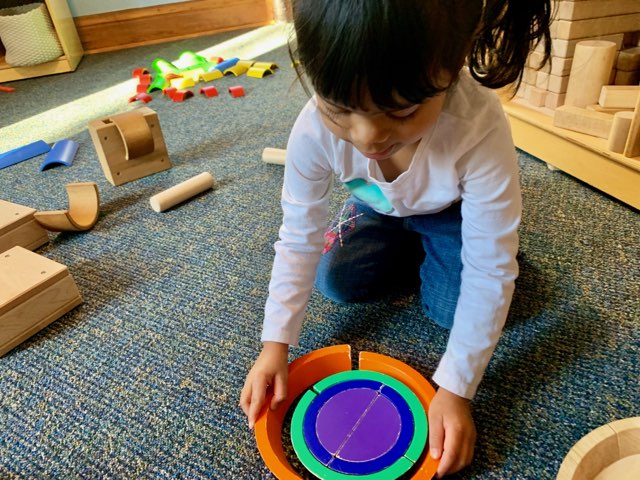
Suddenly it all clicks into place. The lightbulb of understanding goes on in Saaliha’s mind and I can see her confidence surge as she fits the pieces together more quickly. She’s got it! She’s figured it out! There is no celebration, just a smile of satisfaction. She studies the finished project. Before I can capture her expression of satisfaction, she disassembles the puzzle to do it over again.
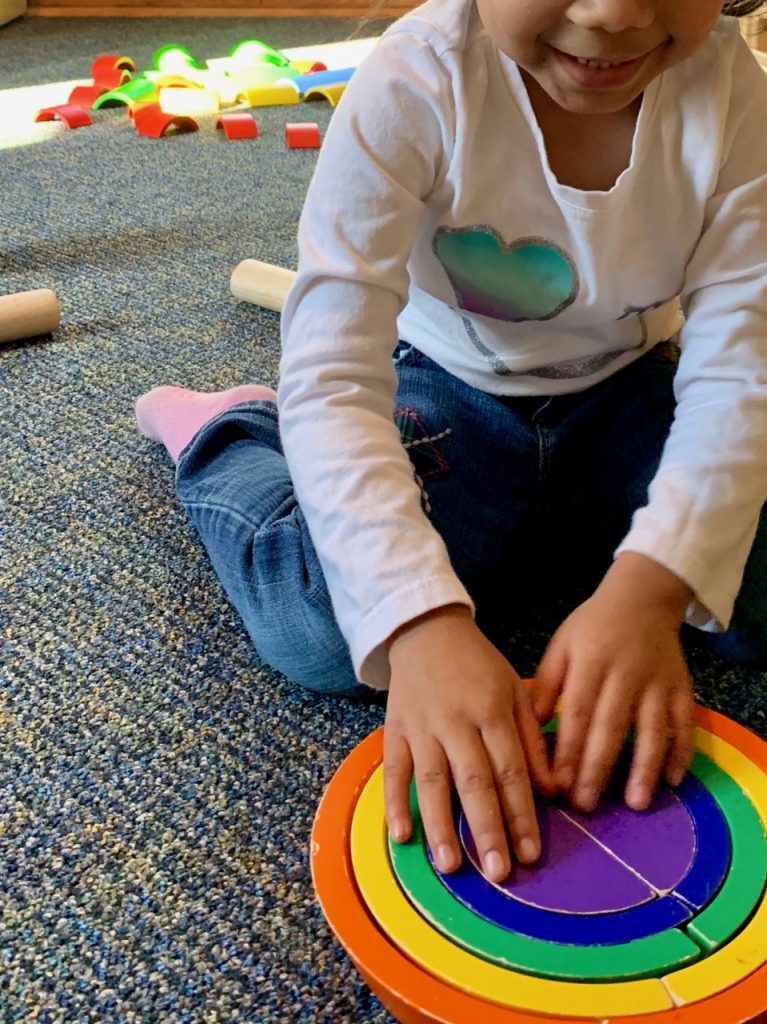
Saaliha continues to struggle and I continue to observe her strategies and methods of choice. Her perseverance continues to reward her with success and a better understanding of the puzzle in front of her. She is a finely tuned machine, working on all cylinders as she masters the task at hand with patience and confidence.
Puzzles offer a wide variety of developmental benefits and enable children to learn important skills as they play. From critical thinking and problem solving to concentration and attention span to spatial awareness, playing with puzzles adds layer upon layer to our strong math foundation!
This is such a fantastic analysis of what is happening in the child’s mind as she is persistent and engaged in solving the puzzle!! Thank you Diann!
I really liked this activity, the children are engaged and their involvement enhances language and social skills.
Thanks for sharing this blog. It was fascinating watching her figure things out for herself
The comparison with the two year classmate’s ability and tolerance in problem solving was amazing as we got to see the three year old really exhibit some developmental growth as she observed but did not attempt to forcibly remove puzzle pieces , waiting patiently to see what might happen and the her persistence continued as she continued to do the puzzle.
Puzzles are just great learning opportunities for all children and even adults. You get to try out things before making a decision which is great practice for other tasks in life
Puzzles are one of the easiest but best ways for a child learning math. By knowing spatial awareness the child can figure out a number of different things.
What if you work with 1 to 1 1/2 year olds what the best approach to the puzzles?
Puzzles in the eyes of that infant/toddler stage look like shape sorters, hide and seek games, and introducing place vocabulary. Words like, IN, OUT, UP, DOWN, etc. Rolling a ball, but rolling a square block looks differently. Just introducing the child to lots of deep thinking through play!
Reading this reminds me of times I’ve watched children in my care work on different types of puzzles. It always makes me smile to see them persist and really work on it without any realization of the world around them. This particular puzzle is unique and has it’s own special challenges. Thank you for sharing!
I love that she does not need outside praise she gives herself all the praise she needs. Self worth is so important.
Mary
Puzzles are a great way to stimulate the mind and help children think about the patterns in their world.
Puzzles help with problem solving and develops their reasoning skills and communication skills.
Puzzles are very great self learning skills!
Puzzels meet so many standards with young children. I lovrd how she used her eyes, hands, fingers, and brain in problem solving and putting together the puzzle. I also enjoyed how she let her friend put together a part of the puzzle without getting upset. I also enjoyed seeing her own satisfaction in problem solving and putting together the puzzle. She didn’t give up. Awesome.
Ada
This is pretty cool, fun and was easy for the child. It also show predictability.
I always have puzzles available to the children. They love fitting the pieces together and telling me why the piece does or doesn’t fit. Letting them tell me the why, just reinforces their retaining the concept we’re working on.
Love how she tries to work at this on her own and once her friend joins they work together to achieve it to the end.
Puzzles are and awesome tool to use to help promote problem solving skills
Agreed puzzles are wonderful for problem solving.
I love how her determination and patience was captured here. She kept persevering even after her friend lost interest. Her smile in the last photo was everything.
I find that puzzle play appeals to many children and that their problem-solving skills are honed by the increased us of more complicated puzzles. They will compare shapes, sizes, colors and the right “fit” with each attempt….Marc
I love how she continues to try different ways of putting the pieces together. She is determined to put it together the right way and seems to enjoy the challenge.
I agree. She manipulates the pieces to get them to fit the right way. i love her persistence and determination to solve the problem!
Puzzles and shapes are amazing in children being able to touch them ans organize them into making eith the picture or creating something from the blocks.
Puzzles are such a wonderful way to engage with children and the think I enjoyed most about the article was the part about the younger child and the older child working together to figure the puzzle out.
I love how engaged the child is and how well she works with a friend. I just love using puzzles in the classroom.
I absolutely enjoyed your observation and narration of a creative and persistent child hard at work with spatial reasoning and patterning!
I absolutely enjoyed your observation and narration of a creative and persistent child hard at work with spatial reasoning and patterning! Puzzles are the best natural lessons on problem solving.
I absolutely enjoyed your observation and narration of a creative and persistent child hard at work with spatial reasoning and patterning! Puzzles are the best natural lessons on problem solving.
This is a great activity for the children to explore patterns and analyzing what piece fits or comes next. It is a great way for them to use critical thinking skills.
Is a really good activity but how can I adapted to toddlers?
How can I adapt this activity for toddlers? this is a great activity.
This is a great way to compare non standard measurements using different sized blocks.
puzzles are a great thing to do to recognize and work with patterns in a classroom
I like this activity. Saaliha is really engaged in this activity and is really using her problem solving skills.
cathy b so much learning going on here
Puzzles are a great activity to use for many things.
I love to watch children doing a puzzle that challenges them. When they figure it out the
expression on their faces is priceless.
I thought it was great how Saalina observed her friend so that she could problem solve without asking for help. This puzzle activity increased her thinking abilities, attention span, and curiosity. I like how her confidence increased after she was able to fit the pieces together.
Saalina demonstrated good problem solving abilities, and was persistent in learning how to reach a successful outcome while mastering the puzzle pattern.
I liked how the child was persistent with this puzzle activity.
When children solve puzzles they are using their critical thinking skills. I love to watch students engage in puzzle activities.
It was fascinating to see her concentration as she figured this out and had her light bulb moment
This was a great example of exploring and conquering a challenging task of putting a puzzle together. I have has a 2 year old just pull out magnetic blocks and begin to piece them together. Not knowing how they all work at the beginning but she just began to put them all together and at the end she put triangles together to make a circle. It was just amazing on how her thinking was.
I enjoyed seeing her work the puzzle and figuring out how it fit together.
Puzzles are an excellent way to help children problem solve and spatial awareness. I liked the way the child stayed focused on what she was trying to do. When she figured it out, how she realized what she had done.
The little girl in the video with the rainbow puzzle is, though she might not be aware of it, practicing completing patterns both in color and shape.
It put a smile on my face went a child grasp a concept that they are working on.
What a fantastic analysis! I love having the opportunity to observe a child who is deep in learning through play just as the child in this blog post was. Puzzles are a wonderful way to engage children in math language on so many levels- from sorting (if pieces from more than one puzzle are mixed together) to talking about attributes to spatial awareness. Great post!